What Is Monero?

Monero is a secure, private, untraceable currency that is open-source and freely available to all. You are your own bank, you control and are responsible for your funds, and nobody can trace your transfers. Want to find out more? An overview of Monero's main features are below, and if you'd like to try Monero for yourself the Getting Started section is an excellent launching point.
How Secure Is Monero?
Using the power of a distributed peer-to-peer consensus network every transaction is cryptographically secured. Individual accounts have a 25 word mnemonic seed displayed when created, and can be written down to backup the account. Account files are encrypted with a passphrase to ensure they are useless if stolen.
- Overview - Table of Contents
- What Is Monero?
- Getting Started With Monero
- How To Get A Monero Wallet?
- Monero Resources
- How To Buy Monero?
- How To Earn Monero?
- Where To Spend Monero?
- What Is Monero Mining?
- Latest Monero News
How Private Is Monero?
Monero uses a cryptographically sound system to allow you to send and receive funds without your transactions being easily revealed on the blockchain (the distributed ledger of transactions). This ensures that your purchases, receipts, and all transfers remain absolutely private by default.
How Traceable Is Monero?
By taking advantage of ring signatures, a special property of certain types of cryptography, Monero is able to ensure that transactions are not only untraceable, but have an optional measure of ambiguity that ensures that transactions cannot easily be tied back to an individual user or computer.It is very easy to start using Monero.
- Step 1: Get A Monero Wallet.
- Step 2: Get Some Monero at the best Monero exchange.
- Step 3: Use Your Monero.
- Step 4: Stay Up-to-Date.
While several digital forms of currency have been propelled and many have endeavored to give clients more noteworthy protection, they have seen fluctuating levels of achievement.
Bitcoin, the principal cryptographic money to scale, was initially touted as giving clients obscurity. The digital currency's convention endeavored to offer an abnormal state of protection by protecting client characters behind pseudonymous locations, haphazardly created series of numbers and letters. Nonetheless, this approach demonstrated insufficient.
Bitcoin locations and exchanges are both recorded on the blockchain, making them freely accessible. Despite the fact that an individual bitcoin address is pseudonymous, it can join to numerous exchanges after some time, making it simpler for companions, family and even government offices to show signs of improvement feeling of the address proprietor's obtaining patterns.
While some believed that bitcoin kept their exchange history totally private, associations, for example, law requirement offices have utilized blockchain examination to track bitcoin exchanges.
In the years after bitcoin was discharged, certain digital forms of money were produced particularly to furnish clients with a more noteworthy shot of staying mysterious. Dash, for instance, bridles a component in light of CoinJoin, which joins reserves from a few clients to diminish the odds that any one client's character will be distinguished.
Zcash, another security situated cryptographic money, use zero-learning evidence developments called zk-SNARKs to enable clients to trade data without uncovering their characters. Also, the money's blockchain does not reveal the estimation of any exchanges.
This present digital currency's dispatch created critical buildup, however its security highlight is discretionary, and numerous clients have avoided utilizing it. At the season of report, 28% of exchanges were protected.
Monero, by differentiate, is private of course, and it has accomplished the far reaching appropriation of those inspired by utilizing digital currencies to stay unknown.

Monero is an open-source, security situated digital currency that was propelled in April 2014. The designers included presented this inventive cryptographic coin without putting aside any for themselves, and the group has depended on gifts and the more extensive group to facilitate advancement.
Monero use ring signatures and stealth addresses to cloud the personality of senders and recipients. Ring signatures join or 'mix' a client's record keys with open keys got from monero's blockchain to make a 'ring' of conceivable underwriters, which means outside onlookers can't interface a mark to a particular client.
The idea of a ring signatures was first depicted by scholastics from MIT and The Weizmann Institute in a 2001 paper, and utilizing the innovation has given authenticity to monero when a significant part of the cryptography utilized as a part of blockchains is new and has not withstood the trial of time.
It is important that while blending administrations are accessible for some digital forms of money, clients for the most part just blended coins when they were hoping to shroud something. Monero, in any case, blends all coins utilized as a part of exchanges, which wipes out the doubt that coins are being blended to cover data the senders and beneficiaries don't need outsiders to see.
While monero clients can keep their exchange history private, they can likewise share this data specifically. Each monero account has a view key, which licenses anybody holding it to take a gander at the record's exchanges.
Initially, ring signatures clouded the senders and beneficiaries engaged with monero exchange without concealing the sum exchanged. In any case, a refresh called RingCT actualized another ring mark that covered both the estimation of individual exchanges and the character of senders and beneficiaries.
Notwithstanding utilizing ring signatures, monero additionally upgrades protection through stealth addresses, which are haphazardly produced, one-time addresses made for every exchange for the benefit of the beneficiary.

With this component, beneficiaries distribute a solitary address and exchanges they get go to independent, one of a kind locations. Subsequently, monero exchanges can't be connected to the distributed address of the sender or beneficiary.
Fungibility and Reception
By giving an abnormal state of security, monero offers fungibility, implying that every individual unit of a money can be substituted for another. Another method for putting this is each coin has rise to esteem.
Since the exchange history of individual bitcoins is recorded on the blockchain, coins that have been related with specific occasions, similar to burglary, could be avoided by dealers and trades.
Because of monero's untraceable nature, no two coins are discernable from each other, and they are both equivalent according to vendors. Without this level of fungibility, a seller that acknowledges digital currency may decline a unit of one of these benefits as a result of its past exchange history.
Along these lines, monero (XMR) has delighted in an enduring increment in appropriation since its discharge. Dim web commercial centers including AlphaBay and Oasis have grasped the digital currency, apparently because of prevalent request.
"Following the request from the group, and considering the security highlights of monero, we chose to add it to our commercial center," the official statement expressed.
Desert garden received the money soon thereafter, and the supports of these two dull web markets incited huge media scope.
Monero's Market
Monero's market works like that of numerous different digital forms of money. Those keen on putting resources into the cryptographic money can buy it altogether through trades including Poloniex, Bitfinex and Kraken.
Poloniex was the first of these trades to offer the cash, posting eight separate money matches in July 2014. Bitfinex, the biggest bitcoin trade by BTC/USD, stuck to this same pattern in November 2016, posting XMR/USD and XMR/BTC exchanging sets and permitting stores and withdrawals of monero.

Kraken offered monero exchanging beginning in January 2017, posting money sets XMR/USD, XMR/EUR and XMR/XBT. Kraken applauded monero at the time, composing on its blog that the money "exchanges with high volume and liquidity".
In the same way as other different digital forms of money, monero offers invested individuals the chance to mine pieces. While people can join mining pools, they can likewise mine monero without anyone else's input.
Anybody with a PC can partake in this movement, as it doesn't require a particular equipment, for example, the application-particular incorporated circuits (ASICs) required nowadays to mine bitcoin.
- Overview - Table of Contents
- What Is Monero?
- Getting Started With Monero
- How To Get A Monero Wallet?
- Monero Resources
- How To Buy Monero?
- How To Earn Monero?
- Where To Spend Monero?
- What Is Monero Mining?
- Latest Monero News
Monero utilizes a proof-of-work (PoW) calculation that was intended to be available to an extensive variety of processors, a particular that was incorporated to guarantee that mining was interested in a wide range of gatherings rather than simply vast mining pools.
At the season of revealing, the square reward was around 7.46 XMR, implying that the monero organize was creating roughly 224 XMR every hour and 5,376 XMR a day. The system hash rate was 81.84 million hashes for every second.
Value Instability
The cost of monero's XMR token has encountered critical instability now and again, climbing almost 70% in the most recent month and over 1,300% since it started exchanging on CoinMarketCap. Since commencement, the digital currency has vacillated between generally $0.25 (in January 2015) and near $60 (in May 2017).
While some market eyewitnesses may decipher this unpredictability as making monero less dependable, sharp value vacillations give chances to merchants. Merchants can purchase monero utilizing both fiat monetary standards and digital forms of money, which may inspire them to purchase and pitch it trying to make a benefit.
They may likewise utilize the money as a fence for different digital forms of money.
Since monero has gotten the acknowledgment of numerous dim web commercial centers and has created critical perceivability for its capacity to furnish clients with a high level of protection, it is less theoretical than contenders like zcash.
Going ahead, monero's cost will be a component of free market activity. The previous is regularly expanding, and the last is obscure. Strikingly enough, this vulnerability may demonstrate convincing to financial specialists, giving them a chance to estimate on the cryptographic money's future incentive trying to produce solid returns.
Getting Started With Monero?
Using Monero

1. Learn
Monero is a secure, private, and untraceable cryptocurrency. The developers and community are committed to protecting these values. Learn more by reading the What is Monero page. The source code is also available for review and discussion.
2. Request Support
There is a large and supportive community that will assist if you experience any difficulty. See the Hangouts page for more information.
3. Generate a Wallet
A Monero wallet is required to secure your own funds. See the Downloads page for a listing of available wallets.
4. Acquire Monero
Monero may be purchased on an exchange with fiat or other cryptocurrencies. An alternate way of acquiring Monero is via mining, the computationally-complex process whereby transactions are immutably recorded on the blockchain.
5. Send and Receive Monero
Learn how to send and receive Monero by viewing the guide.
6. Transact with Monero
Monero may be used to purchase many goods and services. For a listing, see the Merchants page.
How To Get A Monero Wallet?
monero-wallet-cli
monero-wallet-cli is the wallet software that ships with the Monero tree. It is a console program, and manages an account. While a bitcoin wallet manages both an account and the blockchain, Monero separates these: monerod handles the blockchain, and monero-wallet-cli handles the account.
This guide will show how to perform various operations from the monero-wallet-cli UI. The guide assumes you are using the most recent version of Monero and have already created an account according to the other guides.
Checking your balance
Since the blockchain handling and the wallet are separate programs, many uses of monero-wallet-cli need to work with the daemon. This includes looking for incoming transactions to your address. Once you are running both monero-wallet-cli and monerod, enter balance.
Example:This will pull blocks from the daemon the wallet did not yet see, and update your balance to match. This process will normally be done in the background every minute or so. To see the balance without refreshing:
balance
Balance: 64.526198850000, unlocked balance: 44.526198850000, including unlocked dust: 0.006198850000
In this example, Balance is your total balance. The unlocked balance is the amount currently available to spend. Newly received transactions require 10 confirmations on the blockchain before being unlocked. unlocked dust refers to very small amounts of unspent outputs that may have accumulated in your account.
Sending monero
You will need the standard address you want to send to (a long string starting with '4'), and possibly a payment ID, if the receiving party requires one. In that latter case, that party may instead give you an integrated address, which is both of these packed into a single address.
Sending to a standard address:
transfer ADDRESS AMOUNT PAYMENTID
Replace ADDRESS with the address you want to send to, AMOUNT with how many monero you want to send, and PAYMENTID with the payment ID you were given. Payment ID's are optional. If the receiving party doesn't need one, just omit it.
Sending to an integrated address:
transfer ADDRESS AMOUNT
The payment ID is implicit in the integrated address in that case.
Specify the number of outputs for a transaction:
transfer MIXIN ADDRESS AMOUNT
Replace MIXIN with the number of outputs you wish to use. If not specified, the default is 4. It's a good idea to use the default, but you can increase the number if you want to include more outputs. The higher the number, the larger the transaction, and higher fees are needed.
Receiving monero
If you have your own Monero address, you just need to give your standard address to someone.
You can find out your address with:
address
Since Monero is anonymous, you won't see the origin address the funds you receive came from. If you want to know, for instance to credit a particular customer, you'll have to tell the sender to use a payment ID, which is an arbitrary optional tag which gets attached to a transaction. To make life easier, you can generate an address that already includes a random payment ID:
- Overview - Table of Contents
- What Is Monero?
- Getting Started With Monero
- How To Get A Monero Wallet?
- Monero Resources
- How To Buy Monero?
- How To Earn Monero?
- Where To Spend Monero?
- What Is Monero Mining?
- Latest Monero News
integrated_address
This will generate a random payment ID, and give you the address that includes your own account and that payment ID. If you want to select a particular payment ID, you can do that too:
integrated_address 12346780abcdef00
Payments made to an integrated address generated from your account will go to your account, with that payment id attached, so you can tell payments apart.
Proving to a third party you paid someone
If you pay a merchant, and the merchant claims to not have received the funds, you may need to prove to a third party you did send the funds - or even to the merchant, if it is a honest mistake. Monero is private, so you can't just point to your transaction in the blockchain, as you can't tell who sent it, and who received it.
However, by supplying the per-transaction private key to a party, that party can tell whether that transaction sent monero to that particular address. Note that storing these per-transaction keys is disabled by default, and you will have to enable it before sending, if you think you may need it:
set store-tx-info 1
You can retrieve the tx key from an earlier transaction:
get_tx_key 1234567890123456789012345678901212345678901234567890123456789012
Pass in the transaction ID you want the key for. Remember that a payment might have been split in more than one transaction, so you may need several keys.
You can then send that key, or these keys, to whoever you want to provide proof of your transaction, along with the transaction id and the address you sent to. Note that this third party, if knowing your own address, will be able to see how much change was returned to you as well.
If you are the third party (that is, someone wants to prove to you that they sent monero to an address), then you can check this way:
check_tx_key TXID TXKEY ADDRESS
Replace TXID, TXKEY and ADDRESS with the transaction ID, per-transaction key, and destination address which were supplied to you, respectively. monero-wallet-cli will check that transaction and let you know how much monero this transaction paid to the given address.
Getting a chance to confirm/cancel payments
If you want to get a last chance confirmation when sending a payment:
set always-confirm-transfers 1
How to find a payment to you
If you received a payment using a particular payment ID, you can look it up:
payments PAYMENTID
You can give more than one payment ID too.
More generally, you can review incoming and outgoing payments:
show_transfers
You can give an optional height to list only recent transactions, and request only incoming or outgoing transactions. For example,
show_transfers in 650000
will only incoming transfers after block 650000. You can also give a height range.
If you want to mine, you can do so from the wallet:
start_mining 2
This will start mining on the daemon usin two threads. Note that this is solo mining, and may take a while before you find a block. To stop mining:
stop_mining
View Only Wallets
A view-only wallet can only see which incoming transactions belong to you. It can not spend any of your Monero, in fact it can't even see outgoing transactions from this wallet. This makes view-only wallets particularly interesting for
Developers writing libraries to validate payments
End users validating incoming transactions to cold wallets
Creating A View-Only Wallet
You can create a view-only wallet from any existing wallet.
Open an existing wallet or create a new one using monero-wallet-cli. In the wallet, type address and viewkey to display the wallet's address and secret viewkey. Type exit to close the wallet.
Next, create your view-only wallet by typing monero-wallet-cli --generate-from-view-key wallet-name. The last argument will be your new wallet's file name. You will be prompted for Standard address and View key by the wallet. Paste in your original wallet's address and secret view key. Next, enter and confirm a password for your new wallet and you're done.
Finding a node
First things first, you need to find a node to connect to! moneroworld.com has some great resources for finding nodes. One of the easiest methods would be to use a node run by moneroworld, but they have a tool for finding random nodes too.
Connecting to the node from the GUI wallet
After you enter your password for your wallet, you will see a pop up that will give you the option to "use custom settings". Click on it. You will then be sent to the "Settings" page in the GUI. At this point you should see two text boxes to the right of a label that says "Daemon address".
In the first box (the on to the left) you need to enter the address of the node that you want to connect to. This address might look like node.moneroworld.com or it could look like any old ip address. The smaller box to the right is where you enter the node's port.
The default port is 18081 but if you are using a random node the port that is used will vary. The port for node.moneroworld.com uses 18089.
Monero Resources
How To Buy Monero?
The fees required with obtaining Monero will for the most part be lower on the off chance that you can buy straightforwardly on a Monero exchanging trade, for example, Kraken.
For huge buys, we suggest utilizing a trade. It can take a couple of days to send assets to a trade and get your personality checked with the trade.
On the off chance that you are in a race to purchase Monero to exploit a plunge in costs and you can all the more quickly acquire some Bitcoin, at that point you may want to buy Bitcoin first and afterward immediately change over your Bitcoin to Monero.
You can change over your Bitcoin to Monero either utilizing a BTC/XMR trade benefit or a more straightforward administration like shapeshift.io which does not expect you to enlist. To look for a place to purchase Bitcoin see this rundown.
- Overview - Table of Contents
- What Is Monero?
- Getting Started With Monero
- How To Get A Monero Wallet?
- Monero Resources
- How To Buy Monero?
- How To Earn Monero?
- Where To Spend Monero?
- What Is Monero Mining?
- Latest Monero News
Later on, we anticipate that there will be parts more administrations accessible to give you a chance to buy Monero all the more effectively in your own nation.
BUY MONERO DIRECTLY WITH USD/EUR/GBP/CAD/JPY
- Kraken - Trading exchange via EUR SEPA, USD/EUR Bank Wire, USD/GBP SEPA and SWIFT, JPY/CAD Bank deposit
- Bitfinex - Trading exchange USD
- Poloniex - Trading exchange via Tether USD
- AnyCoin - EU SEPA transfer
- LocalMonero.co - Purchase XMR locally with cash or online
- MoneroForCash - Purchase XMR locally with cash, by mail or money order
- LiveCoin - Wire transfer (SWIFT), OKPAY
- LiteBit - EU SEPA, Paypal
- BuyUcoin - INR
CONVERTING BITCOIN TO AND FROM MONERO
- Shapeshift.io - User friendly interface to exchanges, no account required
- EverCoin - User friendly interface to exchanges, no account required
- Bitsquare
- XMR.to - Monero to Bitcoin only
- Alfa Cashier
- TuxExchange
- In addition to these services, use any of the exchanges listed in the "BTC/XMR Exchanges" section. Shapeshift is the easiest method in our experience, since there is no need to sign up for an account.
OTHER XMR EXCHANGES
- Bisq - P2P exchange
- Bithumb - Korean WON
- BitMEX - Monero futures contracts
- Bter - CNY
- Btc38 - CNY
- BTCAlpha - BTC
- Cryptomate - GBP
- Cryptopia - Doge, USDT, NZDT, LTC, BTC
- Cryptox - BTC
- southXchange - BTC, USD
- TuxExchange - BTC
How To Earn Monero?
On the off chance that you as of now have Bitcoin or different digital forms of money, you can exchange them for Monero at cryptographic money trades. Bittrex and Poloniex are the bigger trades, with Poloniex having the most volume of Monero exchanges.
A rundown of trades which exchange Monero might be found here. Expenses on the trades shift, however 0.25% when purchasing appears to be standard.
Bitsquare.io is a decentralized trade, implying that you can exchange Bitcoin and different cryptographic forms of money for Monero distributed through their open-source programming. Until further notice, their charges are somewhat higher than the concentrated trades, yet you do have expanded obscurity with decentralized trades.
Trades function admirably, however they require an email address and here and there require other individual data. In the event that you would prefer not to give any of your own data to a trade, you can utilize ShapeShift.io to in a split second change over Bitcoin or different cryptographic forms of money into Monero.
No email or watchword is required. On the off chance that you store Bitcoin, you can be sent ("Moneroj" is plural for "Monero") right away (inside a couple of minutes).
At the season of this article, Monero's cost was around 12.5% higher on ShapeShift than it was on the trades, yet the accommodation, speed, and more noteworthy obscurity might be justified, despite all the trouble to you.
You'll need a Monero wallet and Monero deliver to which ShapeShift can send your Moneroj, so make sure to set those up in advance.
Despite the fact that Monero doesn't have an authority Graphical User Interface (GUI) wallet yet, it is being developed. You can utilize the official Command Line Interface (CLI) wallet, or the electronic MyMonero.com wallet.
MyMonero is anything but difficult to utilize and your private keys are not put away on their server. In any case, it's best practice to utilize web wallets for just quick needs and not for putting away vast sums. This applies to all web wallets, not simply MyMonero.
The above methods require you to already have Bitcoin or other cryptocurrencies in order to get Moneroj. But what if you don’t have Bitcoin? You can post a free ad to buy Monero with cash at MoneroForCash.com.
No email is required to register, although you can provide an email later if you want to receive notifications about your ad from the site. Sellers have to pay “around $0.09 US” per ad.
Aside from the registration page which uses a CAPTCHA, the site doesn’t use JavaScript, so it’s TOR-friendly. You can choose to buy Monero in person with cash, through the mail with cash or money order, or other methods.
- Overview - Table of Contents
- What Is Monero?
- Getting Started With Monero
- How To Get A Monero Wallet?
- Monero Resources
- How To Buy Monero?
- How To Earn Monero?
- Where To Spend Monero?
- What Is Monero Mining?
- Latest Monero News
Since trading is person-to-person, your Moneroj never goes to the site and thus can’t be stolen by the site or hacked from the site. The site is new and doesn’t appear to have many users yet. In any case, you’ll need to have a Monero wallet and address before you can receive Moneroj.
Where To Spend Monero?
Merchants of all kinds have come to value the financial privacy that Monero brings. Below is a list of the merchants that we know of that currently accept Monero for their goods and services.
Exchanges
- #monero-otc (OTC)
- Alfacashier
- Bitfinex (XMRUSD, XMRBTC)
- Bisq; decentralized exchange (previously Bitsquare)
- BitMEX
- Bittrex
- Bter
- CoinCut (OTC)
- Cryptopia
- Kaiserex
- Kraken (XMRUSD, XMREUR, XMRBTC)
- Liberalcoins
- Livecoin (BTC and USD trading pairs)
- LiteBit (Bankwire/GiroPay/iDeal/SOFORT)
- Magnetic Exchange
- MoneroDirect (Euro only)
- Poloniex
- ShapeShift (Instant)
- Tux Exchange
Payment Gateways
What Is Monero Mining?
It is very easy to solo mine with the official GUI. If you have not done so already, go to the Monero downloads page and download the official GUI for your operating system. Then, run the setup and be patient as Monero synchronizes with the network. You should see that it displays "Connected" in the lower left corner.
Solo Mine With The GUI
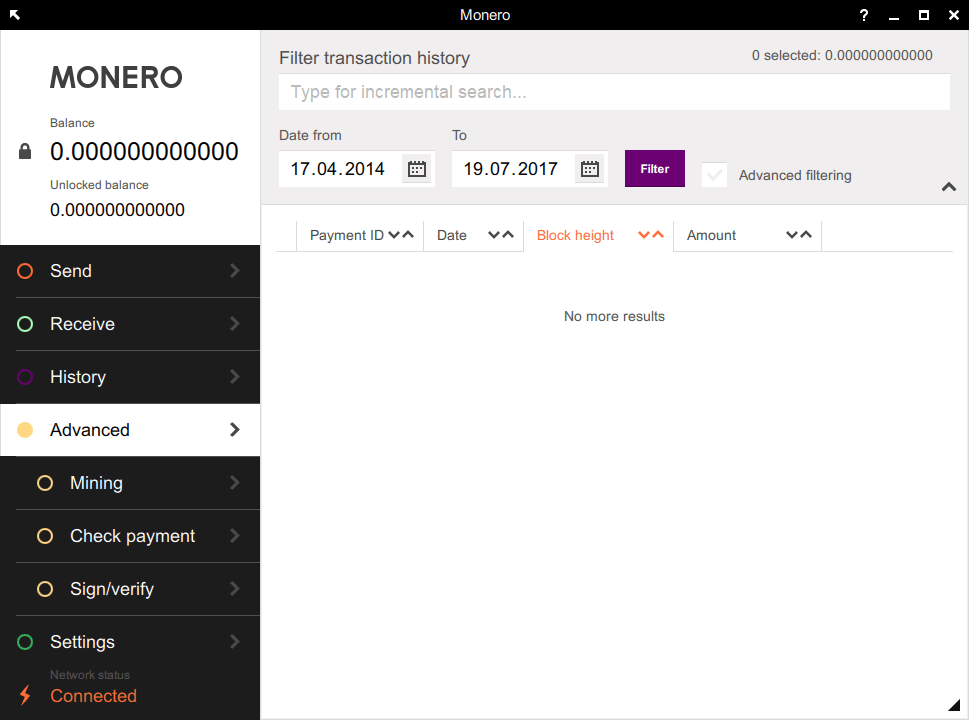
Click on the "Advanced" tab. You should see that several other options appear. Now click on the "Mining" sub-tab.
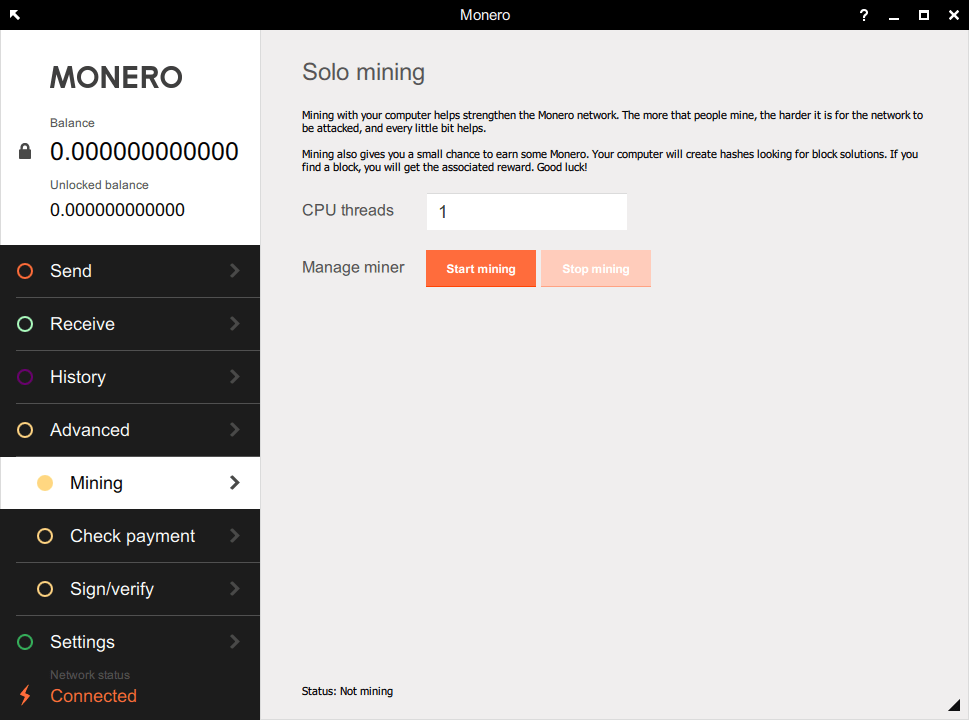
You should now have an option to start mining. You can optionally change the number of threads to mine with. For optimal efficiency, you should mine with your CPU's cache divided by 2. You will need to look up your CPU's specs on the manufacturer's website. If you are unsure, leave the number of threads at 1. Click the "Start mining" button.
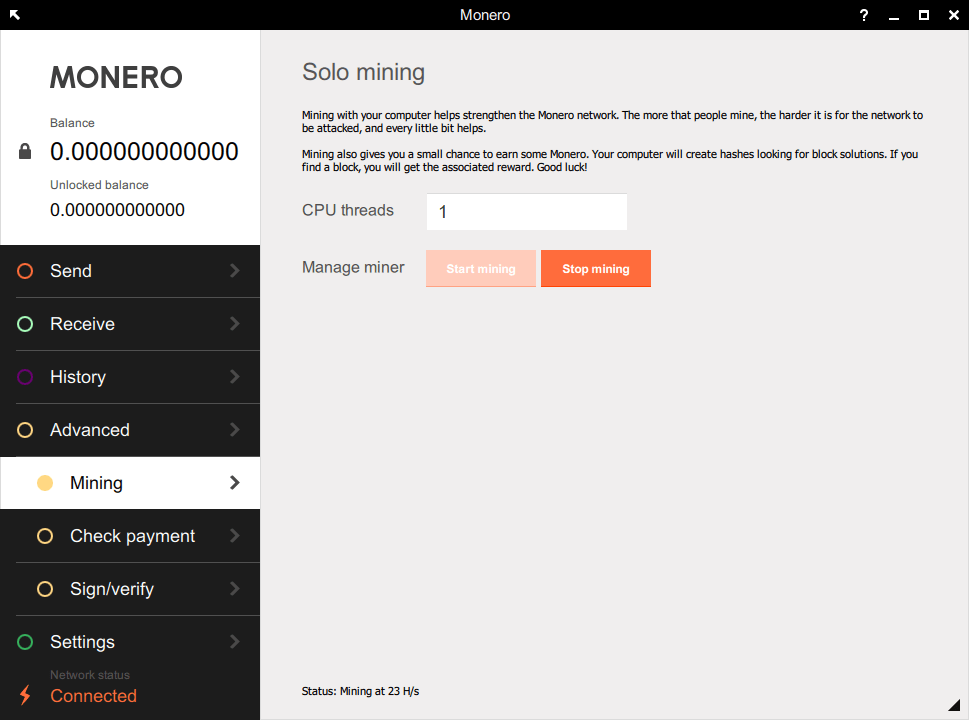
You are now mining with the network, as you can see on the bottom of the image. In this example, the computer is contributing 23 H/s to the Monero network. Mining helps keep the network secure, and you may get lucky and receive a reward for protecting the network.
To stop mining, simply click the "Stop mining" button.
Mine On Pool With xmr-stak-cpu
Selecting a poolThere are many pools to choose from, a list is available at moneropools.com. Mining on a larger pool could mean more frequent payouts, but mining on a smaller pool helps to keep the network decentralized.
Selecting a CPU minerJust like pools, there are a lot of miners to choose from. The one that you should pick depends on the hardware you want to mine on. This guide will only use a CPU miner, and will be using xmr-stak-cpu.
Alternatives include wolf's CPUMiner and sgminer-gm. However, their configuration is slightly different and will not be covered in this guide.
For Windows Systems
If you are using a Windows system, the developer of xmr-stak-cpu provides binaries to download on the GitHub release page.
Download xmr-stak-cpu-win64.zip and extract it somewhere you'll be able to find it again.
For Other Operating Systems
If you're not using Windows, you will have to compile xmr-stak-cpu for yourself, luckily this isn't as hard as it sounds. Before you can compile the miner, you will need to install some of its prerequisites.
For Debian-based distros:
sudo apt-get install libmicrohttpd-dev libssl-dev cmake build-essential
For Red Hat based distros:
sudo yum install openssl-devel cmake gcc-c++ libmicrohttpd-devel
Following this, you just need to use cmake to generate the build files, run make and copy the config file:
mkdir build-$(gcc -dumpmachine)
cd $_
cmake ../
make -j$(nproc)
cp ../config.txt bin/
cd bin
Don't celebrate just yet, as the miner needs to be configured. Running the miner now should give you a block of text to copy and paste:
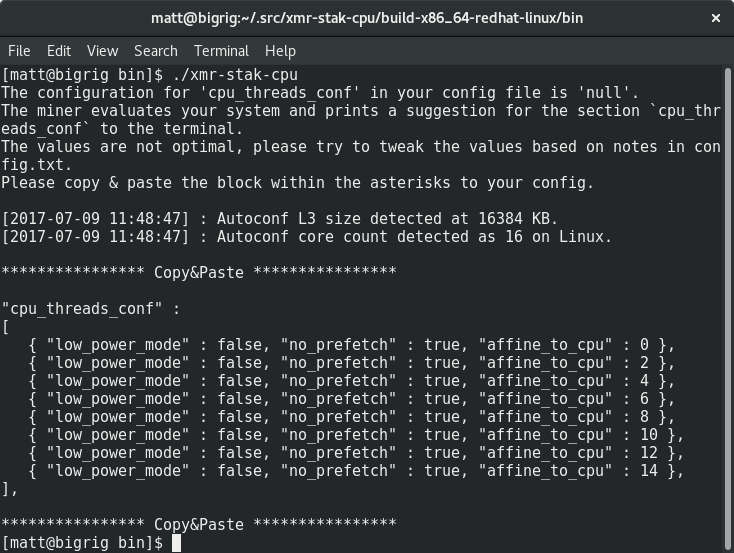
Open config.txt and replace the two "cpu_threads_conf" lines with the text you just copied. It should look something like this afterwards:
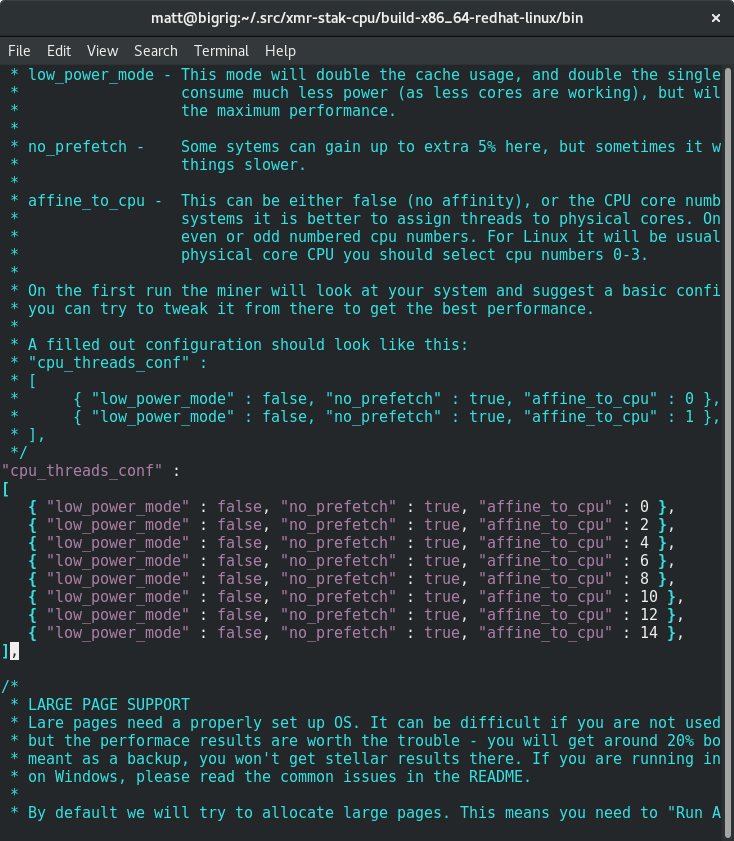
Scroll down in the file until you see the lines containing "pool_address". Replace the contents of the second set of quotes with the address and port of the pool you chose earlier. You can find this information on the pool's website.
Put your wallet address between the quotes on the wallet address. You may leave the password blank unless the pool specifies otherwise.
After this, your config should look something like this:
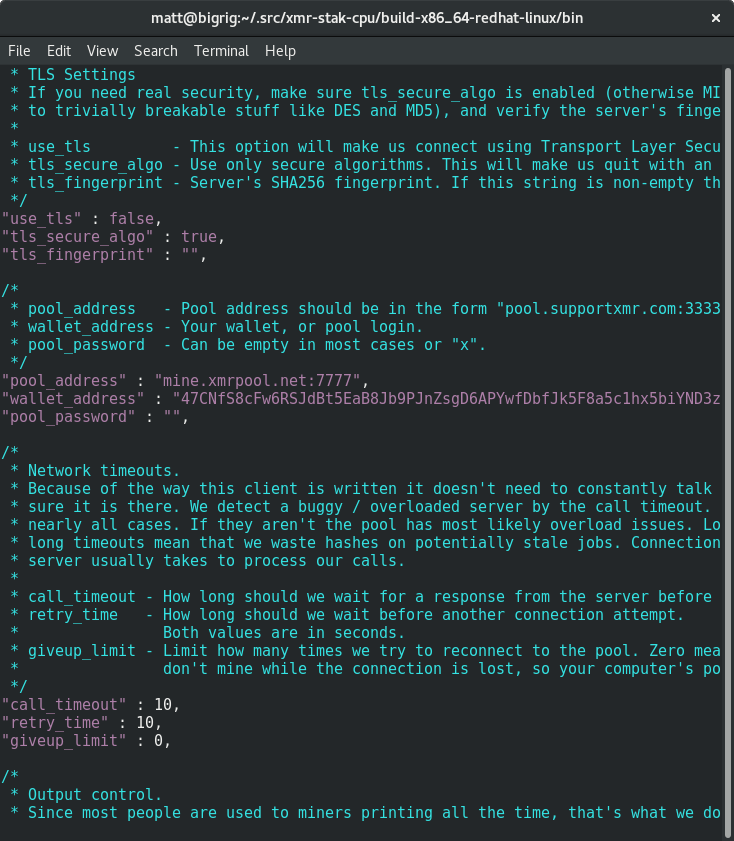
Running the miner
Save the config file and run the miner!
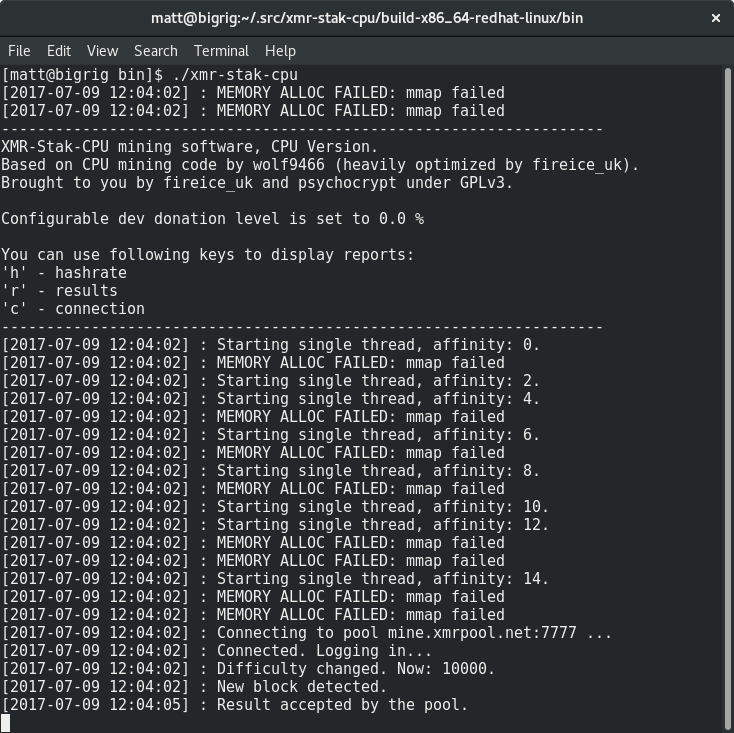
Some pools allow you to monitor your hashrate by pasting your address into their website. You can also monitor your hashrate by pressing the h key.
Tuning the minerYou might see nasty messages like this:
[2017-07-09 12:04:02] : MEMORY ALLOC FAILED: mmap failed
This means that you can get around a 20% hashrate boost by enabling large pages.
Large pages on Linux
Firstly stop the miner (if it's running), run the following commands to enable large pages and then start the miner as root:
</code>sudo sysctl -w vm.nr_hugepages=128
sudo ./xmr-stak-cpu
</code>Large pages on Windows
Taken from config.txt:
By default we will try to allocate large pages. This means you need to "Run As Administrator" on Windows You need to edit your system's group policies to enable locking large pages. Here are the steps from MSDN
On the Start menu, click Run. In the Open box, type gpedit.msc.
On the Local Group Policy Editor console, expand Computer Configuration, and then expand Windows Settings.
Expand Security Settings, and then expand Local Policies.
Select the User Rights Assignment folder.
The policies will be displayed in the details pane.
In the pane, double-click Lock pages in memory.
In the Local Security Setting – Lock pages in memory dialog box, click Add User or Group.
In the Select Users, Service Accounts, or Groups dialog box, add an account that you will run the miner on
Reboot for change to take effect.
Mining With XMRig and Docker
This guide is two fold, ease of use for mining on Linux distributions and some extra security around mining as most of these miners have not had security auditing.
At the end of this guide you will be able to sleep a little easier knowing that if the miner gets exploited it will not migrate to your OS.
Why Docker
Docker is being used as it is the most well known and has the biggest chance to be already installed.
The container I an using is alpine-xmrig as per the name it is built on the Alpine Linux image.
If you are interested in getting started with Docker, here are some really good starting references.
Why XMRig
XMRig is just a really solid miner to me. Nice output and statistics, no flashy web-ui's or dependencies. The XMRig container is only ~4MB what makes it extremely portable.
Step 1: Mining with XMRig
Run the following
docker run --restart unless-stopped --read-only -m 50M -c 512 bitnn/alpine-xmrig -o POOL01 -o POOL02 -u WALLET -p PASSWORD -k
docker run --restart unless-stopped --read-only -m 50M -c 512 bitnn/alpine-xmrig -o pool.supportxmr.com:7777 -u 45CJVagd6WwQAQfAkS91EHiTyfVaJn12uM4Su8iz6S2SHZ3QthmFM9BSPHVZY388ASWx8G9Wbz4BA24RQZUpGczb35fnnJz -p docker:secret -k
Step 2: There is no Step 2
You have already done everything you need to do. You are now mining in a docker container with XMRig ctrl+c to exit the miner or add -d just after docker run to background the miner.
Latest Monero News
Monero 0.11.0.0 "Helium Hydra" Released
This is the v0.11.0.0 major release of the Monero software, and it is a mandatory update due to the September 15th hard fork, which in turn increases the minimum ring signature size to 5 across the network, bans duplicate ring members in a ring signature, and enforces use of ringCT for all transaction outputs. This release of the software presents a number of major improvements to Monero, as well as a large set of bug fixes.
- Overview - Table of Contents
- What Is Monero?
- Getting Started With Monero
- How To Get A Monero Wallet?
- Monero Resources
- How To Buy Monero?
- How To Earn Monero?
- Where To Spend Monero?
- What Is Monero Mining?
- Latest Monero News
Trade Recommendation: Monero
The price bounced from SMA50. RSI confirmed price reversal and MACD histogram supports upward movement. We have trading opportunity and we could open long trades based on reversal signal. But the price can’t pass through 100.00 resistance level. It will be better to place pending orders for buy above this resistance level and the downtrend line.
Estimated entry level should be at 110.00 with stop at 70.00 level. Profit target will be at 144.00 level. If the market can break the downtrend line, it will be a good confirmation of further upward movement. If you don’t use leverage, recommended trading volume for this trade is up to 5% from your deposit.
